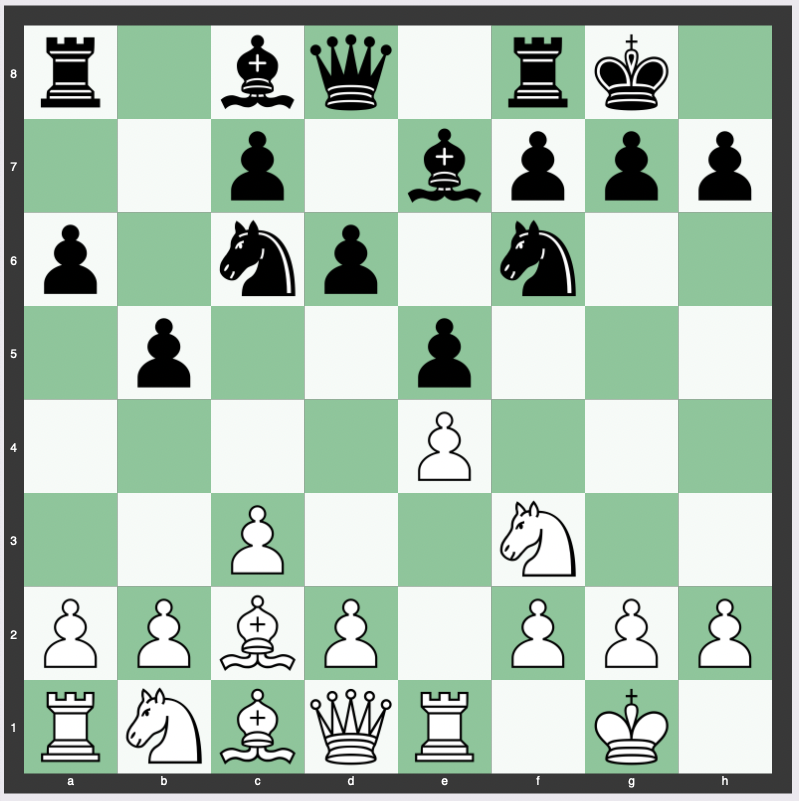The Lutikov Variation is a fascinating and complex line within the Ruy Lopez, one of the oldest and most respected chess openings.
It has been played by many top players and has a rich history and deep theoretical background.
Here we look at the Lutikov Variation, delving into its move order, theory, strategy, variations, history, and its suitability for different levels of players.
We will also look at how often it is played at the Grandmaster level.
Move Order of the Lutikov Variation
The Lutikov Variation follows the sequence 1. e4 e5 2. Nf3 Nc6 3. Bb5 a6 4. Ba4 Nf6 5. O-O Be7 6. Re1 b5 7. Bb3 d6 8. c3 O-O 9. Bc2.

This sequence of moves leads to a rich and complex middlegame. Both sides have various options, and the game can quickly branch into different variations.
Theory, Strategy, and Purpose of the Lutikov Variation
The Lutikov Variation aims to create a flexible and solid position for both sides.
White’s Bc2 move prepares to support the center with d4, while Black’s setup allows for counterplay on the queenside.
The strategic complexity of this line offers rich opportunities for both tactical and positional play.
Understanding the underlying principles and typical plans is essential for success in this variation.
Sub-Variations of the Lutikov Variation
Within the Lutikov Variation, there are several sub-variations and continuations.
These can lead to different pawn structures and tactical themes.
Some of the main continuations include the immediate d4 by White or various knight maneuvers by Black.
Exploring these variations can provide players with a deeper understanding of the possibilities within the Lutikov Variation.
9…d5, 9…Re8, or 9…Bg4 is considered the best reply for black. White still maintains a positional edge.
Continuation lines within the Lutikov Variation include:
9…Re8
9… Re8 10. h3 d5 11. exd5 Qxd5 12. d4 exd4 13. cxd4
9… Re8 10. a4 Bd7 11. d3 Rb8 12. Nbd2 h6 13. h3 Bf8 14. Nf1 b4 15. d4 bxc3 16. bxc3 exd4 17. cxd4 Nb4 18. Ng3 Nxc2 19. Qxc2
9… Re8 10. a4 Rb8 11. axb5 axb5 12. h3 Bf8 13. d4 h6 14. d5 Ne7 15. b3 Bd7 16. c4 Ra8 17. Rxa8 Qxa8 18. cxb5 Bxb5 19. Be3
9…d5
9… d5 10. d4 Nxe4 11. Nxe5 Nxe5 12. dxe5 Bf5 13. Be3 Qd7 14. Nd2 Nxd2 15. Qxd2 c6 16. h3 Rac8 17. f4 Bxc2 18. Qxc2
9… d5 10. d4 Nxe4 11. Nxe5 Nxe5 12. dxe5 Bf5 13. Be3 Qd7 14. g4 Be6 15. f3 Nc5 16. h3 f5 17. exf6 Rxf6 18. f4 Qd6 19. Qf3 Raf8 20. f5 Bd7 21. Nd2
9… d5 10. d4 exd4 11. e5 Ne4 12. h3 Bb7 13. cxd4 Nb4 14. Be3 c5 15. dxc5 Nxc5 16. Nd4 Nxc2 17. Qxc2 Re8 18. Nd2 Rc8 19. N2f3 Ne4 20. Qd1
9…Bg4
9… Bg4 10. h3 Bh5 11. a4 d5 12. axb5 axb5 13. Rxa8 Qxa8 14. exd5
9… Bg4 10. h3 Bh5 11. d3 d5 12. Nbd2 Re8 13. g4 Bg6 14. Nh4 d4 15. Ndf3 Nd7 16. Nf5 Bxf5 17. exf5
9… Bg4 10. d3 h6 11. h3 Bh5 12. g4 Bg6 13. Nbd2 Nh7 14. Nf1 Ng5 15. Kg2 Rb8 16. Ng3 Nxf3 17. Qxf3 a5 18. Nf5 Bxf5 19. gxf5 Bg5 20. Rg1 Bxc1 21. Raxc1
History of the Lutikov Variation
The Lutikov Variation is named after the Soviet Grandmaster Anatoly Lutikov.
It has been played by many top players throughout history and has been a subject of extensive analysis.
The variation has evolved over time, reflecting changes in chess understanding and style. Its rich history adds to the allure of this complex opening.
Is the Lutikov Variation Good for Beginners or Intermediates?
The Lutikov Variation can be suitable for both beginners and intermediate players.
For beginners, it offers a solid foundation and introduces important chess principles. Intermediate players can delve deeper into the variation’s complexities, exploring different plans and tactical themes.
However, the depth of the theory may be challenging for some, so a thorough study is recommended.
How Often Is the Lutikov Variation Played at the Grandmaster Level?
The Lutikov Variation is not as commonly played at the Grandmaster level as some other lines within the Ruy Lopez.
However, it has been employed by several top players and remains a viable option.
Its rich strategic content and the opportunities for unexplored ideas make it an interesting choice for those looking to delve into a less-trodden path.
ECO C90 Ruy Lopez, Closed, Lutikov Variation (White perspective)
Conclusion
The Lutikov Variation of the Ruy Lopez is a fascinating and complex opening that offers rich strategic and tactical opportunities.
Its history, variations, and underlying principles make it an engaging study for players of all levels.
Whether you are a beginner looking to understand fundamental chess concepts or an intermediate player seeking to deepen your understanding of this particular line, the Lutikov Variation has something to offer.
Its unique blend of solidity and complexity ensures that it will continue to be a subject of interest and exploration in the chess world.


